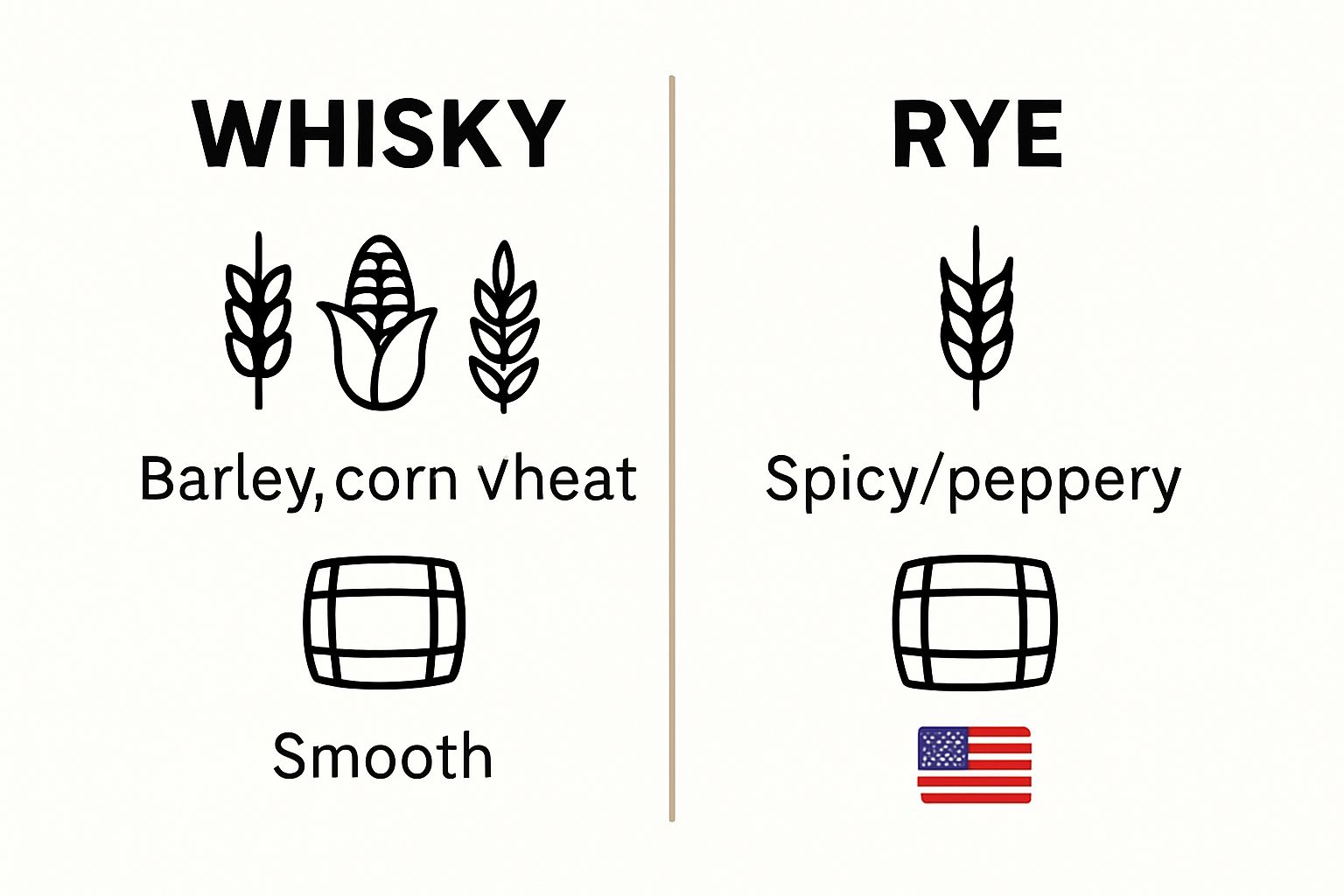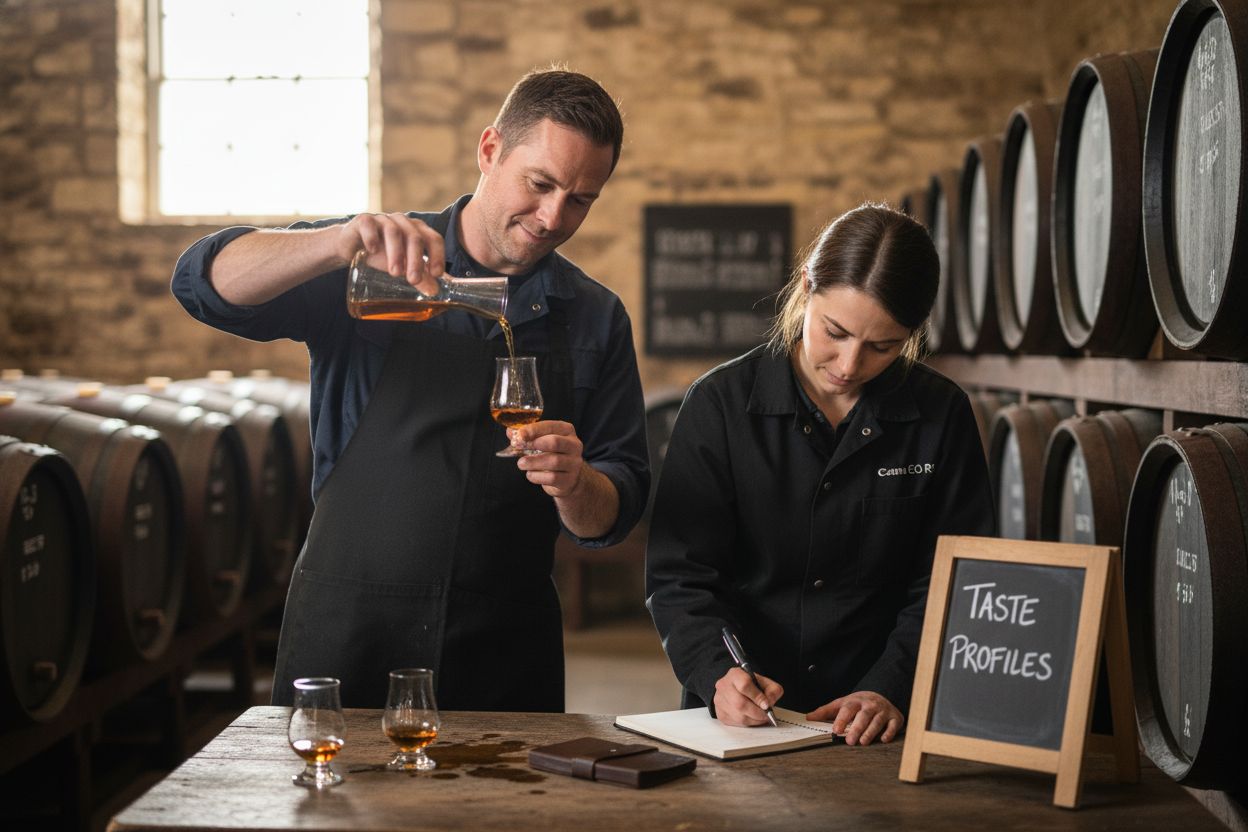Whisky and rye might look similar on the shelf, but their stories and flavours couldn’t be more different. Most people think whisky is just about smoky notes and old traditions. Actually, the secret is in the grain. Rye whisky must be made with at least 51 percent rye grain, giving it a punchy, spicy kick that sets it worlds apart from smoother, sweeter whiskies. This single rule changes everything about the taste and history of your drop.
Table of Contents
- What Defines Whisky And Rye: Key Characteristics
- The Historical Roots: Origins Of Whisky And Rye
- The Production Process: How Whisky And Rye Are Made
- Taste Profiles: Understanding Flavours And Aromas
- Cultural Significance: The Role Of Whisky And Rye In Society
Quick Summary
| Takeaway | Explanation |
|---|---|
| Grain composition distinguishes whisky and rye | Whisky can include various grains, whereas rye must have at least 51% rye grain, affecting taste and classification. |
| Regulatory standards define production processes | Specific laws govern the types of grains and aging methods used in whisky and rye production, ensuring quality and authenticity. |
| Rye whisky features unique flavours | Rye whisky is known for its spicier and more robust flavour profile, characterized by notes of pepper and other spices. |
| Historical roots tie spirits to culture | The origins of whisky and rye reflect agricultural practices and traditions that shaped local communities and their identities. |
| Social connections fostered through whisky and rye | These spirits play a key role in celebrations and gatherings, enhancing social bonds and cultural narratives shared across generations. |
What Defines Whisky and Rye: Key Characteristics
Understanding the nuanced world of whisky and rye requires a deep dive into their fundamental characteristics and production processes. These spirits, while seemingly similar, possess distinct identities shaped by ingredients, distillation techniques, and regulatory standards.
The Grain Foundation
At the core of whisky and rye differentiation lies the primary ingredient: grain. Whisky represents a broad category of spirits produced from fermented grain mash, which can include barley, corn, wheat, or rye. According to Britannica’s comprehensive spirits overview, the specific grain composition dramatically influences the final product’s flavour profile and classification.
Rye, in contrast, is a more specific type of whisky where rye grain must constitute at least 51% of the mash bill.
 This requirement creates a distinctive spicier, more robust flavour compared to other whisky varieties. Our curated selection of rye whiskies showcases the unique character these spirits can deliver.
This requirement creates a distinctive spicier, more robust flavour compared to other whisky varieties. Our curated selection of rye whiskies showcases the unique character these spirits can deliver.
Regulatory Distinctions
Whisky production is governed by stringent regional regulations that define its character. Scottish whisky (Scotch) must be produced in Scotland using malted barley, while bourbon requires a mash bill of at least 51% corn and must be aged in new charred oak barrels. Rye whisky, particularly in the United States, follows its own precise standards.
Key characteristics that differentiate whisky and rye include:
- Grain Composition: Whisky can use multiple grains, while rye must predominantly feature rye grain
- Flavour Profile: Rye typically presents a spicier, more assertive taste compared to smoother whisky varieties
- Geographical Variations: Whisky production spans multiple countries, with each region offering unique production methods
The complexity of these spirits lies not just in their ingredients, but in the intricate processes of fermentation, distillation, and aging that transform simple grains into sophisticated alcoholic beverages.
Below is a comparison table highlighting the key differences between whisky and rye as discussed in the article.
| Aspect | Whisky | Rye Whisky |
|---|---|---|
| Primary Grain | Barley, corn, wheat, or rye (varies by type) | Must have at least 51% rye grain |
| Flavour Profile | Can be smooth, sweet, smoky, or subtle | Spicy, robust, often peppery with bold intensity |
| Regional Variations | Produced globally (Scotland, Ireland, Japan, etc) | Mainly North America (USA, Canada), some Europe |
| Regulatory Standards | Vary across global whisky types | Strict 51% rye rule in US and Canada |
| Ageing Requirements | Varies by style (Scotch, bourbon, etc.) | Must be aged in new charred oak barrels (US rule) |
The Historical Roots: Origins of Whisky and Rye
The story of whisky and rye is a fascinating journey through centuries of agricultural innovation, cultural practices, and artisanal craft. These spirits emerged not merely as beverages, but as profound reflections of regional traditions and human ingenuity in transforming grains into complex, nuanced alcoholic drinks.
Ancient Beginnings and Monastic Traditions
Whisky’s origins can be traced back to medieval monasteries, where monks first developed distillation techniques. According to historical research, Irish and Scottish monks began experimenting with spirit production in the early Middle Ages, initially creating medicinal elixirs from fermented grain mash. These early alchemical processes laid the groundwork for what would become a globally celebrated spirit.
Rye whisky, particularly in North America, has a distinct narrative rooted in agricultural practicality. Explore our deep dive into whisky history to understand how European settlers brought their distillation knowledge to the New World, adapting their techniques to local grain availability.
Regional Evolution and Cultural Significance
The development of rye whisky in North America was closely tied to agricultural realities. In regions where corn struggled to grow, rye became a robust and reliable crop. Farmers discovered that excess rye could be transformed into a valuable commodity through distillation. By the late 18th century, rye whisky had become a staple in northeastern United States and Canadian agricultural communities.
Key historical milestones in whisky and rye development include:
- 1400s: Monastic distillation practices emerge in Ireland and Scotland
- 1700s: Rye becomes a primary grain for whisky production in North America
- 1800s: Commercial distilleries begin standardizing production techniques
These spirits evolved from humble agricultural products to globally respected beverages, representing not just a drink, but a complex narrative of human creativity, cultural adaptation, and technological innovation.
The Production Process: How Whisky and Rye Are Made
The transformation of grains into whisky and rye is an intricate craft involving precise techniques, scientific understanding, and generations of accumulated knowledge. Each stage of production contributes to the spirit’s unique character, flavour profile, and ultimately, its quality.
Mashing and Fermentation
The production journey begins with careful grain selection and preparation. For rye whisky, at least 51% rye grain must be used in the mash bill. According to distillation research, the grains are ground, mixed with water, and heated to convert starches into fermentable sugars. This mash is then cooled and yeast is introduced, triggering fermentation where sugars are converted into alcohol.
Each grain type imparts distinct characteristics. Rye produces a spicier, more robust base compared to other grains, which directly influences the final spirit’s flavour profile.
Explore our premium rye whisky selection to experience these nuanced differences.
Distillation and Maturation
Distillation represents the critical transformation stage where fermented liquid is heated and the alcohol is separated from water and other compounds. Whisky and rye undergo multiple distillation rounds, typically in copper stills, which help refine and concentrate the spirit. The number of distillations and still design significantly impact the final product’s complexity and smoothness.
Key stages in whisky and rye production include:
- Grain Selection: Determining the precise grain mix and quality
- Mashing: Converting grain starches into fermentable sugars
- Fermentation: Transforming sugars into alcohol using specific yeast strains
- Distillation: Concentrating and purifying the alcoholic liquid
- Aging: Developing flavour complexity in wooden barrels
Maturation occurs in wooden barrels, typically oak, where the spirit absorbs flavours from the wood and undergoes chemical changes that enhance its taste and aroma.
This table summarises the main stages involved in the whisky and rye production process to help visualise how each step contributes to the final spirit.
| Stage | Description |
|---|---|
| Grain Selection | Choosing specific grains for the mash bill (at least 51% rye for rye whisky) |
| Mashing | Grinding grains, mixing with water, heating to convert starches to sugars |
| Fermentation | Adding yeast to the mash to convert sugars into alcohol |
| Distillation | Heating fermented liquid in stills to separate and concentrate alcohol |
| Ageing/Maturation | Placing spirit in wooden barrels (usually oak) to develop flavour and aroma over time |
Taste Profiles: Understanding Flavours and Aromas
The sensory experience of whisky and rye represents a complex interplay of ingredients, production techniques, and aging processes. Each spirit offers a unique aromatic and flavour journey that reflects its origin, grain composition, and crafting methodology.
Rye Whisky: Spice and Complexity
Rye whisky distinguishes itself through a bold, assertive flavour profile characterized by pronounced spiciness and robust intensity. Scientific analysis of spirits reveals that the high percentage of rye grain creates a distinctive peppery, sometimes almost sharp taste that sets it apart from smoother whisky varieties. The grain’s natural characteristics contribute notes of cinnamon, nutmeg, and black pepper, creating a dynamic and engaging drinking experience.
Explore our curated rye whisky collection to experience these intricate flavour nuances firsthand. Each bottle represents a unique expression of this remarkable spirit.
Whisky Varieties: A Spectrum of Sensory Experiences
Traditional whisky offers a broader range of flavour profiles depending on its grain composition and geographical origin. Scotch whiskies typically present more subtle, complex flavours with hints of smoke, sea salt, or heather, while bourbon showcases sweeter notes of vanilla, caramel, and toasted oak.
Key flavour characteristics to understand include:
- Grain Impact: Different grains produce distinct baseline flavours
- Aging Influence: Wooden barrel characteristics dramatically shape taste
- Regional Variations: Production location introduces unique flavour elements
- Maturation Duration: Longer aging often creates more refined, smoother profiles
The interaction between grain, distillation technique, and barrel aging creates a symphony of flavours that transforms these spirits from simple alcoholic beverages into complex sensory experiences.
 Understanding these nuances allows enthusiasts to appreciate the remarkable craftsmanship behind each carefully produced bottle.
Understanding these nuances allows enthusiasts to appreciate the remarkable craftsmanship behind each carefully produced bottle.
Cultural Significance: The Role of Whisky and Rye in Society
Whisky and rye transcend mere beverages, representing profound cultural narratives that reflect historical traditions, social connections, and national identities. These spirits are not simply alcoholic drinks, but intricate symbols of heritage, craftsmanship, and community storytelling.
National Identity and Heritage
According to Canadian historical research, rye whisky embodies more than a drink it represents a cultural touchstone. In Canada, for instance, ‘rye’ has become synonymous with whisky itself, reflecting deep agricultural and social roots. Scottish whisky similarly serves as a global ambassador for Scottish culture, with each region’s distinctive production methods telling stories of local landscapes and generational knowledge.
Explore our curated whisky collection to understand how these spirits capture complex cultural narratives through their unique production methods and regional characteristics.
Social Rituals and Connections
Whisky and rye have long functioned as social lubricants, facilitating conversation, celebration, and community bonding. From Scottish Highland gatherings to North American frontier settlements, these spirits have been integral to social interactions, marking significant life moments and creating shared experiences.
Key cultural dimensions of whisky and rye include:
- Ceremonial Significance: Used in toasts, celebrations, and important social gatherings
- Economic Impact: Supporting local agricultural and distilling economies
- Artistic Inspiration: Influencing literature, music, and visual arts
- Generational Knowledge: Passing traditional crafting techniques between generations
Beyond consumption, these spirits represent intricate narratives of human creativity, resilience, and cultural expression. Each bottle carries within it not just a drink, but a story of human connection, innovation, and tradition.
Ready to Taste the Real Difference Between Whisky and Rye?
After exploring what sets whisky apart from rye in tradition, taste, and craft, you might feel overwhelmed by all the choices and technical jargon. Maybe you’re searching for that spicy rye experience mentioned in the article, or perhaps you want to compare how a smooth Scotch stands up against a bold American rye. The problem is, not all bottles are created equal – and it can be difficult to know where to begin if you want premium quality and authentic flavours.

Don’t let uncertainty hold you back from finding your perfect pour. At Uisuki.com.au, you get access to a hand-picked selection featuring rare and world-renowned bottles from Scotland, Japan, Australia, and the USA. Whether you crave the spicy punch of rye or the mellow notes of classic whisky, our detailed guides, product listings and genuine community reviews make it simple to discover bottles tailored to your taste. Curious where to start? Browse our expert-curated range and take your journey from education to enjoyment. For extra insights about whisky history or bottle recommendations, check out our educational articles or sample a unique rye whisky today. Experience the world of whisky the right way – visit Uisuki.com.au and elevate your collection now.
Frequently Asked Questions
What is the main difference between whisky and rye?
Whisky is a broad category of spirits made from fermented grain mash, while rye specifically refers to whisky that must contain at least 51% rye grain. To understand their unique characteristics better, taste both types side by side to compare their flavour profiles.
How does the grain composition affect the taste of rye and whisky?
The grain composition is crucial, as rye offers a spicier and bolder flavour than other whisky types. Experiment with different brands of rye and other whiskies to appreciate how the type of grain influences the overall taste experience.
Are there specific regulations that define rye whisky?
Yes, rye whisky must consist of at least 51% rye in its mash bill, while other whiskies like bourbon must have 51% corn. Review the regulations for different types of whiskies to grasp the production standards and taste variations.
How does the aging process influence the flavour of whisky and rye?
Aging allows both whisky and rye to absorb flavours from the wood barrels, enhancing their taste and aroma. Observe the differences between young and aged varieties, and take notes on how aging changes the drinking experience over time.
Can you explain how fermentation works in whisky and rye production?
Fermentation is the process where yeast converts sugars from grains into alcohol, impacting the final flavour of the spirit. Follow the fermentation timeline during production to understand how it contributes to the distinctive characteristics of whisky or rye.
What types of flavours can I expect from rye whisky compared to traditional whisky?
Rye whisky typically features spicier, more robust notes like cinnamon and black pepper, while traditional whisky can have a variety of flavours including sweetness or smokiness. To gain a better understanding, taste both spirit types with a focus on identifying specific flavour notes.

